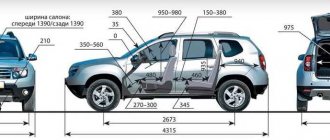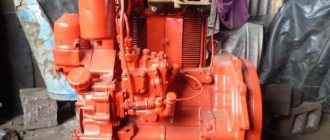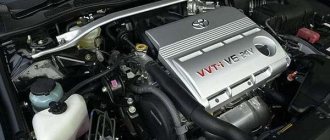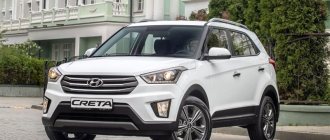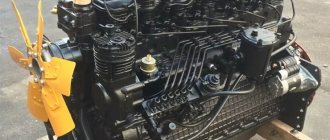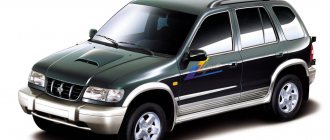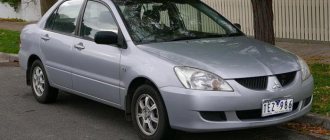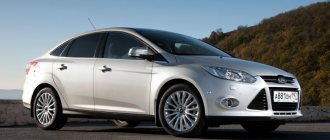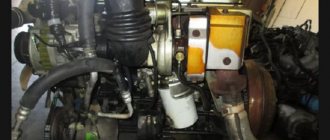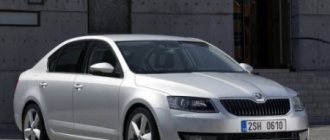About the history of the model
This family is the same age as the famous Olympics-80: mass production of the first generation Renault Trafic started in 1980. It replaced the Renault Estafette vans produced since 1959.
It was decided to install the motors longitudinally in order to ensure good loading of the front drive axle. The base for this model was a gasoline carburetor engine with a displacement of 1.4 liters and a power of 48 horsepower.
Since 1984, Renault Traffic cars have been put into production with 1.65-liter gasoline engines with a capacity of 65 horsepower, with a five-speed manual gearbox or a three-speed automatic transmission. Since 1987, the family’s range has included a 1.7-liter 68 hp engine, as well as an all-wheel drive version with a 2-liter 82 hp engine. A diesel engine also appeared (2.1 l, 65 hp). It fit in the engine compartment with great difficulty: to do this, the radiator grille had to be pulled forward, like a drawer on a chest of drawers.
Renault Traffic first generation
It was decided to restyle the Renault Trafic in accordance with current trends in automotive design in 1989. Then they changed the elements of the front part of the car - the hood, fenders, headlights, radiator grille. The cabin design, finishing and sound insulation have been improved. All modifications were given indexes in accordance with their carrying capacity (in kilograms): T900, T1100 and T1400. The main engines were diesels: 1.9 l, 61 hp. and 2.5 liters, 76 hp, there is also a petrol option - a 2.2-liter injection. In 1997, the appearance of Renault Traffic was updated once again.
The second generation of Renault Trafic came out in 2001, and the following year the car won the title of “International Van of the Year”. The second generation was also produced under the names Nissan Primastar, Opel Vivaro and Vauxhall Vivaro (the latter version for the UK). The second generation of Renault Traffic gained great popularity - over the years of its production, more than one and a half million of these cars were manufactured. The main engines were a two-liter turbocharged diesel engine with 114 hp. and a gasoline injection engine with a power of 116 hp, a working volume of also 2 liters. In 2006, the car's exterior design was restyled.
Second generation
In 2014, a completely new Renault Trafic was introduced to the market - the third generation of the cargo-passenger family. These third-generation commercial vehicles are equipped with diesel engines with a displacement of 1.6 and 2 liters, with power ranging from 90 to 140 hp. There is also a petrol injection version. In 2021, production of the Trafic X-Track version was launched: with a limited slip differential, increased ground clearance and underbody protection.
Russian official Renault dealers do not sell new Renault Trafic III generation cars. But Ukrainian Renault dealers have them in their assortment.
Model history and purpose
1st generation
The premiere of the first generation Renault Trafic took place in 1981.
The car in the brand's model line replaced the Renault Estafette, produced since 1959. The new family includes front-wheel drive frame vans with a gross weight of 2300-2700 kg and a load capacity of 800-1200 kg. The rear door of the vehicle was made hinged, the halves opened 180 degrees. In 1989, the car was seriously modernized. The developers completely revised the front part, installing new fenders, a radiator grille, a hood and headlights. The design of the model, seat trim and sound insulation have been improved. The carrying capacity of Renault Traffic vehicles has increased by an average of 100 kg. At the same time, the vehicle retained the longitudinal layout of the engine, which ensured good loading of the drive axle. The main engines in the restyled version were 1.9-liter (61 hp) and 2.5-liter (76 hp) diesel engines. A 2.2-liter fuel-injected engine was also available. In 1997, the Renault Trafic I was awaiting another facelift. There are fewer sharp edges, giving the car a more modern look. However, the brand failed to save the model, which was seriously outdated by that time. Due to the ugly rectangular design, backward dashboard and very uncomfortable interior ergonomics, Renault Traffic was noticeably inferior to its competitors. Demand for the car was rapidly falling.
2nd generation
In 2001, the French introduced the second generation Renault Trafic with a modern appearance and design. The model turned out to be very successful and a year later received the title “International Van of the Year”. Renault Traffic 2 has undergone revolutionary changes compared to its predecessor. All models are equipped with a wide sliding side door located on the right. The appearance of the car immediately caught the eye: sweeping body lines, a clearly distinguished cabin, a powerful bumper and teardrop-shaped headlights. The functionality of the machine has also improved (load capacity, useful volume). Renault Trafic II was offered with a 2-liter gasoline engine (120 hp) and two 1.9-liter diesel engines (80 and 100 hp). The units were distinguished by low fuel consumption. Everything in the car cabin was done ergonomically and conveniently. In addition, the second Renault Traffic was considered one of the safest full-size minivans of that time. As standard, it was equipped with ABS with EBV, disc brakes and special seat belts.
3rd generation
In the summer of 2014, sales of the third generation Renault Trafic started.
The design of the second generation, which has not lost its relevance, has been changed for the better. The model received a massive front part, making it more brutal. What especially stood out here were the huge pointed headlights, the large curvy bumper and the impressive brand badge. The manufacturer also improved the technical filling, increasing traction. Renault Traffic III added efficiency and economy. Sales of the third generation of the car have not yet begun on the Russian market. Russians have access to only used versions of Renault Traffic supplied from abroad.
In 2021, the Trafic X-Track premiered with increased ground clearance, additional underbody protection and a limited slip differential.
The model was developed specifically for transporting small delegations of large companies, where every little detail is important. However, the car has proven itself well as a van, allowing, if necessary, to transport bulky cargo. In total, the French brand offered several dozen modifications of the Renault Trafic, which allowed the consumer to choose the model that best suits his goals.
Features of the Trafic family vehicles
Renault Traffic minivans and vans are available in a wide range of cargo, passenger and cargo-passenger versions, with standard or extended body lengths. At the same time, the dimensions of the car vary from 3.75 m to 5.4 m in length, with a standard width of 2.283 m.
The front and rear overhangs, compared to the previous generation, have been increased by 100 mm each. The angles of approach and departure remained virtually unchanged, but the dimensions of the cargo compartment increased. On a van with a standard wheelbase (L1), its length has increased to 3.75 m, and in the long-wheelbase version - to 4.15 m. At the same time, the total capacity of the cargo compartment on Renault Trafic vans ranges from 5.2 m3 to 8.6 cubic meters , depending on the length of the wheelbase, as well as the roof version (standard or high).
All kinds of body styles are available: a cargo van, a van with an extended cab (Extended Cab), a cargo-passenger “combi” for 6 or 9 passenger seats; There is also a simple chassis with a cab (platform cab) - for the installation of bodies, vans and various special equipment (crane, tow truck, etc.)
All-metal bodies of Renault Traffic cars are available in Passenger or Fourgon versions. The main trim options are the standard Authentique, Expression and comfortable Privilege. More expensive Privilege variants include, among other things, alloy wheels and automatic climate control with an additional work section for rear passengers.
New Renault Traffic cars of the 2021 model in Ukraine are sold, in accordance with demand, only in an extended version: the distance between the bumpers is 5.4 meters. The only gearbox offered is a six-speed manual. There are two engines for cars for sale in the former Soviet republics - both turbocharged diesel engines, 1.6-liter capacity, but with varying degrees of boost - 115 hp. or 140 hp
According to the results of a crash test of new Renault Trafic vehicles of the 2021 model, the Euro NCAP commission gave the van a low rating - only three stars. What played a role here is that the standard equipment of the Renault Traffic does not provide an airbag for the passenger. The risk of whiplash injuries for people sitting in front was assessed as high, however, rear passengers were not considered safe. Since the Renault Trafic does not have side airbags as standard, this was also negatively reflected in the assessment - the car did not pass the side impact test with a pole.
Brief description of Renault Trafic
The first generation Renault Trafic appeared in 1980. The car replaced the aging Renault Estafette. The car received a longitudinally mounted engine, which improved the weight distribution of the front end. Initially, the car used a carburetor engine. A little later, the manufacturer decided to use a very bulky diesel power unit, which is why the radiator grille had to be moved forward a little.
First generation Renault Trafic
In 1989, the first restyling was carried out. Changes affected the front of the car. The car received new headlights, fenders, hood and radiator grille. The cabin sound insulation has improved slightly. In 1992, Renault Trafic underwent a second restyling, as a result of which the car received:
- central locking;
- expanded range of engines;
- second sliding door on the left side;
- cosmetic changes to the appearance and interior.
Renault Trafic first generation after the second restyling
In 2001, the second generation Renault Trafic entered the market. The car received a futuristic appearance. In 2002, the car was awarded the title “International Van of the Year”. Optionally, the Renault Trafic can have:
- air conditioner;
- tow hook;
- roof-mounted bike rack;
- side airbags;
- electric windows;
- on-board computer.
Second generation
In 2006-2007, the car was restyled. The turn signals have changed in the exterior of the Renault Trafic. They have changed from pronounced orange to becoming more integrated into the headlights. After restyling, driver comfort has improved slightly.
Second generation after restyling
In 2014, the third generation of Renault Trafic was released. The car is not officially delivered to Russia. The vehicle is available in cargo and passenger versions with the ability to choose body length and roof height. Under the hood of the third generation you can only find diesel power plants.
Renault Trafic third generation
Suspension, chassis, brakes
The Renault Traffic front-wheel drive chassis with an axle base of 3098 or 3498 mm has independent suspension, lateral stabilization, high-performance disc brakes and advanced active road safety systems. The braking distance of Renault Trafic disc brakes is only 43 meters at a speed of 100 km/h, which is an excellent result even for a passenger car. New modern front shock absorbers contribute to improved handling.
The rear suspension of the truck is a spring suspension with a Panhard rod; it absorbs almost all road irregularities very well. The shock absorbers change their stiffness depending on the degree of load of the car. The ground clearance is 19 cm. For a car of this class, this ground clearance is well suited for operating a truck on domestic roads - it is quite enough.
Renault Traffic engines
In general, Renault Trafic cars are equipped with four diesel and one gasoline engines. Including a 1.6-liter diesel engine with an output of 115 hp/190 N.m or 140 hp/290 N.m (they are sold in the territory of the former USSR). As well as a 1.9-liter dCi with a power of 100 hp, a 2.5-liter dCi with a power of 135 hp. and a 2-liter gasoline injection engine with a power of 120 hp. (there are no such things in new cars sold in the territory of the former Union).
The 1.6-liter diesel engine is a four-cylinder sixteen-valve engine with a Common Rail electronic injection system that meets the requirements of the Euro-5 environmental standard.
Moderate, within 14.3 seconds from 0 to 100 km/h, acceleration characteristics of the 1.6-liter 115-horsepower Renault Traffic diesel engines are compensated by low diesel fuel consumption, at the level of 6.5 -7 liters per 100 km. The 140-horsepower 1.6-liter Twin Turbo power unit has more vigorous acceleration dynamics - it accelerates from 0 to 100 km/h in just 10.9 seconds. At the same time, the motor is quite flexible - 80% of its maximum torque (270 N.m) is achieved already at 1250 rpm.
A multidisciplinary test drive demonstrated that in a forced 140-horsepower version, a diesel drive paired with a six-speed manual gearbox is capable of accelerating a fully loaded car to a speed of 155-160 km/h.
The practice of carriers shows that a loaded van shows an average consumption of diesel fuel in the city - from 7.5 to 8.5 liters. The Eco button located on the tide, near the gear lever, helps to really improve this indicator. This new feature reduces maximum torque and optimizes temperature conditions, allowing real 10 percent diesel fuel savings to be achieved. As for driving on a country highway, when driving uniformly at a speed of 90-100 km/h, it is possible to achieve 5.5 liters per 100 km, but if you drive 120-130 km/h, then the average diesel fuel consumption increases to 7. 5 liters per hundred kilometers.
Renault Traffic - technical specifications.
Thanks to its technical characteristics, Renault Traffic is very reliable and one of the most economical in the class of light-duty trucks.
Economy and power are the hallmarks of Renault Traffic. The minibus is equipped with a DCI turbocharged diesel engine producing 115 hp. At first glance, it may seem that the engine for a minivan with a carrying capacity of 1.2 tons is rather weak, but this is not so. A torque of 290 Nm at 1600 rpm ensures excellent driving performance. The car reaches 100 km/h in 13.6 seconds. Renault Traffic owners will be pleased with their fuel consumption. On the highway it averages only 6.7 liters per 100 km, and in the urban cycle – 9 liters. Engine capacity – 2463 cc. cm.
The engine is paired with a 6-speed manual gearbox, which is smooth.
Ground clearance is 19 cm, which is a very good indicator for a car of this class. Thanks to this ground clearance, the car is suitable for use on Russian roads.
The third generation Traffic is equipped with disc brake systems, thanks to which the braking distance at a speed of 100 km/h is 43 m. Not even all passenger cars can show this result.
The ABS anti-lock braking system, the EBD brake force distribution system, and the AFU anti-skid system make driving the Renault Traffic impeccable. The car holds the road perfectly in all weather conditions.
Reliable seat belts and airbags ensure the safety of both the driver and passengers.
The service interval is two years or 15 thousand kilometers. Fuel tank volume – 90 l Maximum speed – 163 km/h
Transmission Renault Trafic
The Renault Trafic gearbox is a six-speed manual. When the car is not loaded, you can drive it straight from second speed. The first and second gears are quite short, however, if you rev the engine well, they can accelerate to 33 and 57 km/h, respectively. The clarity of the shift is good, but the lever travel in the transverse direction is quite small, so 3rd and 5th gears, as well as 4th and 6th, can be confused at first out of habit. 6th gear is practically not used in the city - it is used only at speeds above 80 km/h, starting from 1500 rpm, on country roads.
The engine pulls literally from the very bottom, and a clearly noticeable pick-up occurs from 1800 rpm. For novice drivers, a system for prompting the optimal gear (which is also available on many Renault passenger cars) will be useful. So, if the speed drops below 1000 rpm (and in higher gears - below 1500 rpm), then an arrow pointing down on the instrument panel lights up: it indicates that you need to engage a lower gear. And vice versa: if the speed exceeds 2300-2500 rpm, an arrow lights up, pointing upward and indicating the need to engage an overdrive.
Renault Trafic cabin and driver's workplace
The range of interior finishing materials of the 2019 Renault Trafic demonstrates that this van or minivan belongs to budget class commercial vehicles. But this does not mean that the interior “smells of cheapness”: no, all materials are very high quality - be it fabric, plastic or artificial leather.
The front panel, compared to the previous generation, has changed very much. In particular, there is no visor across its entire width. A special feature of the new instrument panel is a fully digital speedometer, instead of the usual dial one. The calm two-tone design of the dashboard is pleasing to the eye. The plastic from which it is made is of very high quality, with a pimply texture that is pleasant to the touch. The layout of the internal equipment is characterized by high functionality and convenient access to all the necessary controls and command buttons.
At the bottom of the dashboard there is a technical platform with a handle for switching transmission modes. There is no tunnel as such, so the handbrake lever is installed between the front seats, and each seat is equipped with armrests separately. The steering wheel, trimmed with high-quality leatherette, is equipped with command buttons.
The driver's seat in the third generation Renault Traffic is located 36 mm lower, and it is tilted back by 18 mm. This makes the landing more comfortable, like in a car. As standard, the cushion height is adjustable over a very wide range. For an additional fee, it is possible to adjust the lumbar support. The detailed adjustment in the longitudinal direction is also very pleasing: both a short person and a basketball player can quite comfortably fit in the driver’s workplace. If the configuration includes a single passenger seat, then it will also be equipped with a set of mechanical adjustments. But the double passenger seat is devoid of them.
Renault Traffic 2021
+2
Renault Trafic 2021. Renault has updated its popular Trafic minivan. This minivan has sold thousands of copies around the world. Moreover, it was used equally successfully both as a commercial van and for transporting passengers.
The noticeably updated 2021 model, although fresher, acquired modern and outwardly beautiful optics, remained just as recognizable in profile. To be honest, I never liked this car, precisely because of its side view. It felt like it was some kind of tadpole out of proportion.
The new Renault Traffic 2021, although it acquired additional side edges, retained this feature, although not so clearly expressed. But from the front, he’s just handsome. The front design is very fresh and modern.
Salon
Fresh solutions have also been applied inside. Although the Renault Traffic 2021 feels budget-friendly, the materials are well adjusted, but made from inexpensive plastics, fabrics and even leather.
The low glazing line of the front part creates excellent visibility and a feeling of lightness and spaciousness. The plump steering wheel is very comfortable, and the gear selector, located at hand on the tide of the front panel, is also convenient.
The passenger compartment of a full-fledged minibus, there is a transformation system that allows you to turn the passengers facing each other. There are also folding tables. In general, this is a full-fledged minibus that will perfectly perform its functions as a mobile office or a car for business transfers.
Depending on the length of the Renault Trafic 2021 wheelbase, and there can be two of them (short and long), the volume of cargo space can be from 5.3 m3 to 6.3 m3, load capacity up to 1200 kg.
Renault Traffic 2021 is equipped with a 1.6-liter diesel engine 115 hp/190 Nm or 140 hp/290 Nm. As an alternative, there is a two-liter petrol engine with 116 horsepower.
Renault Trafic. Photo taken from the Yandex Pictures service
As for me, the Renault Trafic 2021 has noticeably freshened up and become noticeably prettier. We have not officially announced any sales yet. But if it does appear with us, it will find its buyer, first of all, who doesn’t want to drive the Peugeot-Citroen-Opel twins... But the key will be the price.
2 784
Similar materials
- Citroen e-SpaceTourer electric minibus for people
- Hyundai Staria began to be sold in Russia
- KIA Carnival HiLimousine first photos in a new body
- Volkswagen ID Buzz Reveals Production Design
- Volkswagen Multivan T7 has a new interior and abandons the mechanics
- Volkswagen Sharan withdrawn from sales after more than ten years
+2
Reviews from drivers and owners of Renault Traffic
On the Internet you can find a lot of positive reviews from domestic drivers who have gained experience driving the Renault Trafic - both about the previous and the current generation of the car. The new version has noticeably improved the sound insulation and vibration protection of the interior, and the engine noise has become almost inaudible.
The car's handling deserves all praise. A steering wheel with good feedback plays a significant role in this; The electric power steering helps quite well when parking (from lock to lock the steering wheel has only 3 turns). Road irregularities are effectively absorbed by the energy-intensive suspension, which adds comfort during operation. You can get used to the pedals quickly. There is one nuance - the clutch takes hold a little late, at the very top.
Good visibility from the driver's seat is also praised. This is due in no small part to the new two-section mirrors. There is a point here: the bottom mirror is made aspherical. Naturally, this expands the viewing angle, but at the same time distorts the image at the edges, which also requires some getting used to.
On long-distance flights, another strong feature manifests itself, which is an advantage of the Renault Trafic chassis - excellent directional stability. Both empty and fully loaded, the van drives in a straight line or in an arc clearly, as if guided by a ruler and compass - it does not move from the chosen trajectory, even if the wheel ends up in a hole.
The rear doors can open at an angle of 90 or almost 180 degrees. To do this, you only need to remove the convenient clamps.
Technical characteristics of Renault Traffic in numbers
- Overall dimensions: length - from 3.75 m to 5.4 m in length, width (with mirrors) - 2.283 m.
- Wheelbase - 3,098 or 3,498 m.
- Front overhang – 933 mm, rear overhang – 968 mm.
- Turning diameter (from curb to curb) – 13.17 m.
- Load capacity – from 900 kg to 1300 kg.
- Curb weight – 1900 kg.
- The maximum permissible trailer weight in tow, with a brake system is 2000 kg, without a brake system - 750 kg.
- Fuel tank capacity is 80 liters.
- The length of the cargo compartment of the van is from 3.75 m to 4.15 m.
- The total capacity of the cargo compartment is from 5.2 m3 to 8.6 m3.
- Volume of the cargo-passenger compartment: in the version with 8-9 seats - 1.8 m3, and if the 3rd row of seats is folded - 3.4 m3. Version 5-6 seats – 4.1 m3.
- Maximum loading length: version 8-9 seats - 1136 mm, version 8-9 seats (if the 3rd row of seats is folded) - 1552 mm, version 5-6 seats - 2050 mm.
- Ground clearance – 190 mm.
- Wheel size – 195/75R16.
- Internal dimensions: maximum width in the cabin – 1662 mm, width between wheel arches – 1268 mm, height – 1369 mm.
- Doors: sliding door width (at a height of 60 cm from the floor) – 907 mm, at a height of 10 cm from the floor) – 1030 mm. The height of the sliding door is 1284 mm. The rear door opening at a height of 70 mm from the floor is 1391 mm.
Cost of new and used Renault Trafic cars in 2019
At the end of 2021, the price of the new Renault Traffic with a 1.6 115 hp engine. starts at 735,800 hryvnia (that’s 1,870,043 rubles); with engine 1.6 Twin Turbo 140 hp. – from 772,700 hryvnia (which means 1,963,824 rubles).
On the secondary market you can find a large number of used Renault Traffic cars. The vast majority are second-generation vans, 2001-2014. release. They ask for from 430 thousand rubles to 1 million 200 thousand rubles, depending on the year of manufacture, mileage and technical condition. Occasionally there are also single advertisements for the sale of old Renault Trafic cars of the first generation, 1987-1999. They ask for about 60-80 thousand rubles.
Renault Trafic III
In this version, the wheelbase has increased significantly, it reached 3498 mm. The dimensions of the body have also increased, which has increased interior capacity and carrying capacity.
The design has also changed: new-shaped headlights with a wide reflector appeared, the radiator grille became more massive, the area of the windshield increased, and new decorative stamping forms appeared on the doors.
The dashboard has completely changed, its layout has become more practical, and the gear shift knob has received a separate niche and is now located closer to the driver.
The seats have changed, they received more expressive lateral support both on the cushion and on the back.
The current version is equipped with a 1.6-liter turbocharged diesel engine. Its power ranges from 115 to 140 hp. (depends on the turbine boost pressure).
